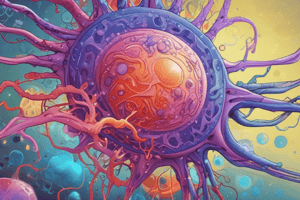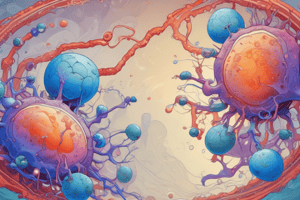Podcast
Questions and Answers
The mechanism of cytotoxic action of CD8+ T lymphocytes includes:
The mechanism of cytotoxic action of CD8+ T lymphocytes includes:
- Nitric oxide (correct)
- Oxygen free radicals (correct)
- IFN-γ (correct)
- Perforin (correct)
Can cytotoxic T lymphocytes induce apoptosis of malignant cells?
Can cytotoxic T lymphocytes induce apoptosis of malignant cells?
- Sometimes
- No
- Only in metastases
- Yes (correct)
The cells responsible for releasing histamine in allergic conditions are:
The cells responsible for releasing histamine in allergic conditions are:
- Lymphocytes
- Mast cells (correct)
- Eosinophils
- Hepatocytes
Cytotoxic T lymphocytes induce apoptosis of malignant cells via:
Cytotoxic T lymphocytes induce apoptosis of malignant cells via:
Differentiation of pre-cytotoxic into cytotoxic T lymphocytes requires:
Differentiation of pre-cytotoxic into cytotoxic T lymphocytes requires:
The term referring to the movement of leukocytes toward bacteria is:
The term referring to the movement of leukocytes toward bacteria is:
The process by which macrophages and granulocytes ingest microorganisms is called:
The process by which macrophages and granulocytes ingest microorganisms is called:
Which factor is significant for the activation of macrophages?
Which factor is significant for the activation of macrophages?
Macrophages express:
Macrophages express:
The reverse transcriptase of the HIV virus performs the following function:
The reverse transcriptase of the HIV virus performs the following function:
The following products of the immune system are opsonins:
The following products of the immune system are opsonins:
Macrophages can kill tumor cells by:
Macrophages can kill tumor cells by:
Which of the following mechanisms do leukocytes use to kill pathogenic organisms:
Which of the following mechanisms do leukocytes use to kill pathogenic organisms:
Macrophages recognize tumor antigens:
Macrophages recognize tumor antigens:
Which viral enzymes assist in the integration of the HIV provirus into the cellular genome:
Which viral enzymes assist in the integration of the HIV provirus into the cellular genome:
Can macrophages phagocytose neoplastic cells?
Can macrophages phagocytose neoplastic cells?
Which statement about TAMs (tumor-activated macrophages) is correct?
Which statement about TAMs (tumor-activated macrophages) is correct?
The C3b component of complement is an opsonin because:
The C3b component of complement is an opsonin because:
Can TAMs induce tumor neovascularization?
Can TAMs induce tumor neovascularization?
Which of the following cells does NOT belong to the family of macrophages:
Which of the following cells does NOT belong to the family of macrophages:
Which of the following statements about interferons is NOT true:
Which of the following statements about interferons is NOT true:
Non-specific immunotherapy of tumors includes:
Non-specific immunotherapy of tumors includes:
Flashcards are hidden until you start studying
Study Notes
Immune System
- The cells responsible for releasing histamine in allergic conditions are mast cells.
- Chemotaxis is the term referring to the movement of leukocytes towards bacteria.
- Phagocytosis is the process by which macrophages and granulocytes ingest microorganisms.
- The reverse transcriptase of the HIV virus transcribes viral RNA into DNA.
Immune Response
- Opsonins are products of the immune system, including Class II MHC products, IgG, and C3b.
- Leukocytes use oxidative activity to kill pathogenic organisms.
- Integrases are viral enzymes that assist in the integration of the HIV provirus into the cellular genome.
- The C3b component of complement is an opsonin because phagocytes recognize it with their receptors.
Immune Cells
- Macrophages possess a receptor for the Fc fragment of IgG.
- Mast cells express a receptor for the Fc fragment of IgE.
- Eosinophils mature in the presence of IL-5.
- B lymphocytes in humans mature in the bone marrow.
- T lymphocytes mature in the thymus.
Immunoglobulins
- IgM appears before IgG in the primary immune response because its production does not require antigen.
- In the secondary immune response, antibody production begins earlier, and IgG concentrations are higher.
- Cell-mediated immunity can be transferred to a non-immune individual by the transfer of T lymphocytes.
- The first immunoglobulin chain synthesized during B lymphocyte maturation is the μ heavy chain.
MHC and Antigen Presentation
- Human Class II MHC products include HLA-DR, HLA-DP, and HLA-DQ.
- Antigen processing is possible in macrophages and other antigen-presenting cells.
- Coreceptor molecules on the membrane of T lymphocytes are CD4 and CD8 molecules.
Immune Response Regulation
- The activation of the complement system via the alternative pathway does not involve C1, C2, and C4.
- If autoreactive cells are not eliminated by negative selection in the thymus, it will lead to autoimmune diseases.
- The function of B lymphocytes is not cytotoxicity.
Immune System Disorders
- In Myasthenia gravis, there are autoantibodies specific for the acetylcholine receptor.
- The presence of the HLA-B27 allele does not represent an increased risk for the development of type I insulin-dependent diabetes mellitus.
- Patients with DiGeorge syndrome lack a thymus and therefore suffer from T cell deficiencies.
Antibody Structure and Function
- The Fab fragment of an antibody does not include the C-terminus of the heavy chain.
- The primary functions of the Fc fragment of an antibody include passage of antibodies through the placenta, binding to mast cells and basophils, and complement activation.
Transplantation and Immunotherapy
- Immunosuppressive therapy is applied in autoimmune diseases and organ transplantation.
- Adoptive immunotherapy of malignant diseases involves the use of LAK cells, which are generated in vitro by high doses of IL-2 acting on NK cells.
- Cytotoxic CD8+ T lymphocytes recognize tumor antigens in the context of Class I MHC molecules.
- Macrophages can induce apoptosis of malignant cells by producing TNF-α and oxygen free radicals.
- TAMs (tumor-associated macrophages) can induce tumor neovascularization.
Studying That Suits You
Use AI to generate personalized quizzes and flashcards to suit your learning preferences.




